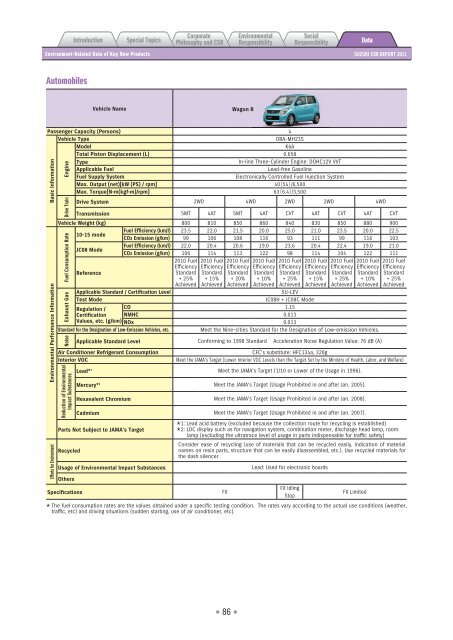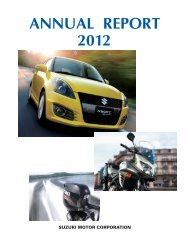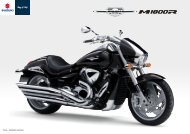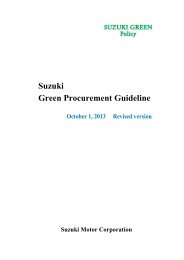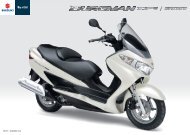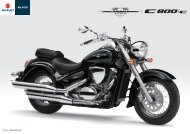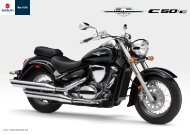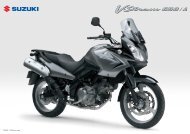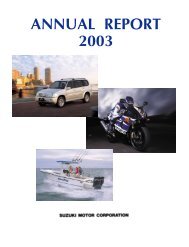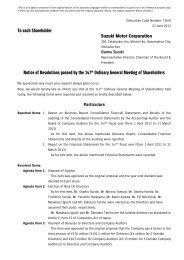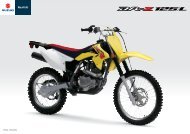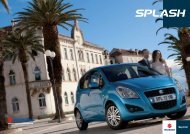2011 Suzuki CSR Report - global suzuki
2011 Suzuki CSR Report - global suzuki
2011 Suzuki CSR Report - global suzuki
You also want an ePaper? Increase the reach of your titles
YUMPU automatically turns print PDFs into web optimized ePapers that Google loves.
Introduction<br />
Special Topics<br />
Corporate<br />
Philosophy and <strong>CSR</strong><br />
Environmental<br />
Responsibility<br />
Social<br />
Responsibility<br />
Data<br />
Environment-Related Data of Key New Products<br />
SUZUKI <strong>CSR</strong> REPORT <strong>2011</strong><br />
Automobiles<br />
Vehicle Name<br />
Wagon R<br />
Passenger Capacity (Persons) 4<br />
Vehicle Type<br />
DBA-MH23S<br />
Model<br />
K6A<br />
Total Piston Displacement (L) 0.658<br />
Type<br />
In-line Three-Cylinder Engine: DOHC12V VVT<br />
Applicable Fuel<br />
Lead-free Gasoline<br />
Fuel Supply System<br />
Electronically Controlled Fuel Injection System<br />
Max. Output (net)[kW (PS) / rpm] 40(54)/6,500<br />
Max. Torque[N•m(kgf•m)/rpm] 63(6.4)/3,500<br />
Basic Information<br />
Environmental Performance Information<br />
Efforts for Environment<br />
Engine<br />
Drive Train<br />
Fuel Consumption Rate<br />
Drive System 2WD 4WD 2WD 2WD 4WD<br />
Transmission 5MT 4AT 5MT 4AT CVT 4AT CVT 4AT CVT<br />
Vehicle Weight (kg) 800 810 850 860 840 830 850 880 900<br />
10-15 mode<br />
Fuel Efficiency (km/l) 23.5 22.0 21.5 20.0 25.0 21.0 23.5 20.0 22.5<br />
CO2 Emission (g/km) 99 106 108 116 93 111 99 116 103<br />
JC08 Mode<br />
Fuel Efficiency (km/l) 22.0 20.4 20.6 19.0 23.6 20.4 22.4 19.0 21.0<br />
CO2 Emission (g/km) 106 114 113 122 98 114 104 122 111<br />
2010 Fuel 2010 Fuel 2010 Fuel 2010 Fuel 2010 Fuel 2010 Fuel 2010 Fuel 2010 Fuel 2010 Fuel<br />
Efficiency Efficiency Efficiency Efficiency Efficiency Efficiency Efficiency Efficiency Efficiency<br />
Reference<br />
Standard Standard Standard Standard Standard Standard Standard Standard Standard<br />
+ 25% + 15% + 20% + 10% + 25% + 15% + 25% + 10% + 25%<br />
Achieved Achieved Achieved Achieved Achieved Achieved Achieved Achieved Achieved<br />
Applicable Standard / Certification Level<br />
SU-LEV<br />
Test Mode<br />
JC08H + JC08C Mode<br />
Regulation / CO 1.15<br />
Certification NMHC 0.013<br />
Values, etc. (g/km) NOx 0.013<br />
Standard for the Designation of Low-Emission Vehicles, etc.<br />
Meet the Nine-cities Standard for the Designation of Low-emission Vehicles.<br />
Exhaust Gas<br />
Noise<br />
Applicable Standard Level Conforming to 1998 Standard Acceleration Noise Regulation Value: 76 dB (A)<br />
Air Conditioner Refrigerant Consumption<br />
Interior VOC<br />
Reduction of Environmental<br />
Impact Substances<br />
CFC's substitute: HFC134a, 320g<br />
Meet the JAMA's Target (Lower Interior VOC Levels than the Target Set by the Ministry of Health, Labor, and Welfare)<br />
Lead* 1 Meet the JAMA's Target (1/10 or Lower of the Usage in 1996).<br />
Mercury* 2 Meet the JAMA's Target (Usage Prohibited in and after Jan. 2005).<br />
Hexavalent Chromium Meet the JAMA's Target (Usage Prohibited in and after Jan. 2008).<br />
Cadmium Meet the JAMA's Target (Usage Prohibited in and after Jan. 2007).<br />
Parts Not Subject to JAMA's Target<br />
Recycled<br />
Usage of Environmental Impact Substances<br />
*<br />
1: Lead acid battery (excluded because the collection route for recycling is established)<br />
2: LDC display such as for navigation system, combination meter, discharge head lamp, room<br />
lamp (excluding the ultratrace level of usage in parts indispensable for traffic safety)<br />
Consider ease of recycling (use of materials that can be recycled easily, indication of material<br />
names on resin parts, structure that can be easily disassembled, etc.). Use recycled materials for<br />
the dash silencer.<br />
Lead: Used for electronic boards<br />
Others<br />
Specifications<br />
FX<br />
FX Idling<br />
Stop<br />
FX Limited<br />
The fuel consumption rates are the values obtained under a specific testing condition. The rates vary according to the actual use conditions (weather,<br />
*<br />
traffic, etc) and driving situations (sudden starting, use of air conditioner, etc).<br />
● 86 ●


